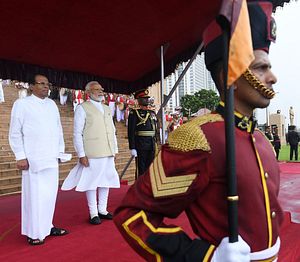Last week, China donated a frigate to the Sri Lankan Navy. While the development itself was hardly surprising, it nonetheless highlighted the continuing contest between India and China in India’s neighborhood in spite of ongoing efforts by both sides to manage their wider relationship.
The frigate arrived in Colombo Port earlier this week. The Commander of the Sri Lankan Navy, Vice Admiral Piyal De Silva, thanked China for the gift and said that this reflected the “good friendship between the two countries.” Commander De Silva went on to add that Sri Lanka faces many maritime challenges and that the frigate, now designated ‘P 625’, will be mainly used for offshore patrol, environment monitoring and anti-piracy efforts.
The vessel reportedly comes with a main turret holding dual Type 79 100 mm cannons and two Type 76A dual-37 mm Anti-Aircraft Guns at the aft. It also has a helipad and hangar to store and operate a medium-size helicopter. A statement from the Chinese Embassy in Sri Lanka said that in addition to the donation, the PLA Navy had also conducted a two-month professional training for more than 110 Sri Lankan naval officers and sailors in Shanghai, China.
The donation of the frigate comes against the backdrop of a major Chinese aid to Sri Lanka to fight terrorism. In May, China decided to provide Sri Lanka with aid to the tune of $14 million for Colombo to procure China-made counterinsurgency equipment. The decision was taken during President Maithripala Sirisena’s visit to Beijing in mid-May, and the president’s office stated that this will be important in enhancing the wherewithal of the Sri Lankan security forces. Reports suggest that China will also be providing the Sri Lankan police with 150 vehicles.
Much like Beijing’s interest in other Indian neighbors, including the Maldives, China’s interests in Sri Lanka are more strategic than economic. Developments such as the visit of a Chinese nuclear submarine to Colombo during the Rajapaksa tenure were a wake up call as well as a reminder to India of the extent of China’s strategic in roads in Sri Lanka. The China-Sri Lanka relationship reached a peak during the final phase of the Sri Lankan war against the Liberation Tigers of Tamil Eelam (LTTE). The political and defense support extended by China to Colombo, in the face of international condemnation on account of the extensive human rights abuses, was significant.
New Delhi has not been sitting still, however. Indeed, the fact that Indian Prime Minister Narendra Modi began his second tenure in office with a stop in Sri Lanka on his way back from a visit to the Maldives was no coincidence. New Delhi has no doubt been aware that domestic political shifts in Sri Lanka have continued to put it in the balance, with Colombo perceived to have moved toward China under former President Mahinda Rajapaksa, and, after the election of Sirisena and Prime Minister Ranil Wickremasinghe, shifting back toward India. New Delhi has also been aware of the risks of Sri Lanka getting entangled in the risks of Chinese engagement, including the Belt and Road Initiative (BRI) with the example of the Hambantota port.
This continues to play out even today. Even though the Sirisena-Wickremasinghe political dispensation has been quite favorable to India, the internal squabble between the two leaders has cast a shadow in its dealings with India. This has affected the manner in which even terrorism issues were dealt with by the two leaders. Despite the fact that India had provided intelligence on the Easter terror attacks in Sri Lanka, it was not given adequate credit due to the continuing row between Sirisena and Wickremasinghe.
The India-China competition in Sri Lanka is quite evident more broadly. India had earlier given Sri Lanka advanced off-shore patrol vessels (AOPVs) – SLNS Sayurala (P623) and SLNS Sindurala (P624) in 2017 and 2018 respectively. But India’s overall capacity to deliver what Sri Lanka needs is questionable. This has been the case even during the war against the LTTE (though that was at least partly because New Delhi was hobbled by the needs of domestic politics) to the extent where China emerged as one of the key trading partners, even setting up a NORINCO small arms factory in Kandy.
The delivery of a Chinese frigate to Sri Lanka is nonetheless evidence that strategic competition in India’s neighborhood will only continue to intensify. Unless India does more for its neighbors and enlists other partners as well, China will continue to present a significant strategic challenge for New Delhi in this regard in the coming years.































